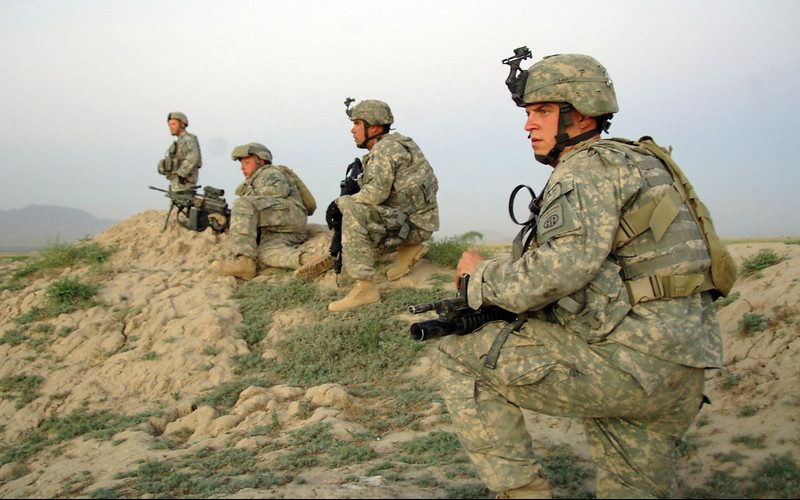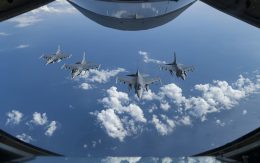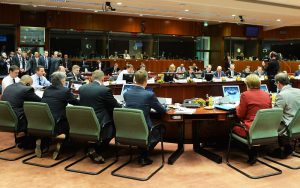The Star Wars franchise is perhaps one of the most culturally important and significant media franchises in film history. The series’ worth is in the billions of dollars and has spawned multiple film trilogies, TV series, book deals, countless action figures, video games, and amusement parks. The series has an immense social impact and much has been written about the series from multiple perspectives, varying from politics to gender to philosophy.
In military circles, the franchise is quite popular, which is not the most surprising given the fact that the military consists of a wide variety of persons from various sections of the American populace. Books on strategy and tactics have been written through the lens of Star Wars while whole branches have utilized Star Wars characters and fans in swearing-in ceremonies.
The series is without question popular, and clearly, many lessons can be learned from the Star Wars universe, lessons on ethics, leadership, and warfare. Currently, in the aftermath of the war in Afghanistan, much can be learned from Star Wars about the practice of Counterinsurgency (COIN). In the fictional universe, the period between the final moments of Episode III: The Revenge of the Sith (ROTS) and Episode VI: The Return of the Jedi (ROTJ) would be when COIN tactics would be most clearly utilized.
With Afghanistan, the United States effectively lost, the Taliban taking control of Kabul and pushing out the Islamic Republic of Afghanistan, the pro-democracy, U.S.-allied government. This is quite similar to how the Empire itself lost to the Rebel Alliance; a large, technologically advanced force being overwhelmed by a smaller, primitive force. However, beyond this similarity of being an insurgency, the Taliban and the Alliance share little else.
Terminology
Before this article tackles the various COIN strategies and successes/failures within Star Wars, it would first be beneficial to define a few concepts.
Counterinsurgency first can be best defined as “the use of all elements of a nation’s power—including not only combined-arms operations but also psychological, political, economic, intelligence, and diplomatic operations—to defeat an insurgency”. An insurgency, as well, is defined as “an organized uprising that uses violent and nonviolent means to overthrow an existing government or to wrest away control, either de jure or de facto, over part of its territory”.
There are also two forms of COIN that are most heavily practiced. According to the well-known blog Small Wars Journal, there are enemy-centric and population-centric approaches. The enemy-centric approach “sees counterinsurgency as a contest with an organized enemy, and believes that we must defeat that enemy as our primary task…In a nutshell, it could be summarized as “first defeat the enemy, and all else will follow”. This enemy-centric approach is something that can be clearly seen with U.S. involvement in Vietnam.
The population-centric approach meanwhile, “understands counter-insurgency as fundamentally a control problem… It believes that establishing control over the population, and the environment (physical, human and informational) in which that population lives, is the essential task… the underlying philosophy is “first control the population, and all else will follow”. This population-centric approach to COIN can be seen in the latter years of the Afghanistan war in addition to certain operations within the Algerian war.
These are two of the more classic forms of counterinsurgency and there has been much innovation within the strategic and tactical applications of this methodology. It should be noted that, when done correctly, population-centric or enemy-centric COIN can be successful, though the U.S. Army’s official Counterinsurgency manual, the FM 3-24, seemingly advocates for a population-centric COIN method (to much criticism).
The Imperial Failures of COIN in Star Wars
From a military perspective, both sides, the Empire and the Alliance, conducted COIN in the worst way possible.
The Empire, firstly, adopted an extreme version of the enemy-centric approach to conquering the galactic system. Their end goal is to conquer the galaxy, put in place a strict, authoritarian government ruled by the Sith Lord Emperor, and eliminate all forms of resistance. Their primary tactic in accomplishing this goal, however, is by defeating the Alliance and wiping out the Jedi in total.
With this strategy, unlike the U.S. Armed Forces in Afghanistan, the only concern is defeating the rebel fighters and pacifying the galaxy of dissent, with zero regard for civilian life. This is best exemplified in A New Hope.
Demanding the location of the Alliance’s headquarters, Darth Vader and Grand Moff Tarkin threaten to destroy Princess Leia’s home planet of Alderaan unless she provides the desired information. Though Leia provides a planet (one not containing the base and being more remote), Tarkin destroys Alderaan “to punish the world for supporting the Rebellion, hoping the annihilation of the entire world would make the rest of the galaxy fear Imperial retribution for supporting the Rebels”.
This strategy is, probably unsurprisingly, an ill-informed one, yet one that can be seen with totalitarian, dictatorial regimes throughout history. If the end result is to simply pacify and destroy an enemy force, then there will be no desire for a military strategy focusing on winning the “hearts and minds” of a civilian population.
Ironically, had the Empire conducted a better COIN strategy, one focusing on assisting local populations in becoming stable, self-sufficient, and working with the locals on developing their regions, providing a better quality of life. However, this type of strategy would be completely anathema to the Empire as, starkly different from the United States, they don’t care about the lives of those under their rule. All that matters is that the civilian population is complacent and abides by the rules put in place by the Emperor.
While the Empire has a very clear ability to conduct COIN effectively and maintain a strong base of support throughout the galaxy, they fail to do this as they are blinded by power.
The Rebel Alliance’s Insurgency
The Rebel Alliance faced many trials in defeating the Empire. First, they did not have the same industrial capabilities, had to work within the shadows and under constant threat of discovery, and were comprised of everyday persons, some of whom were untrained in military arts or strategy. While many insurgencies are able to incorporate the diverse skillsets of their adherents to the overall military effort, this does pose problems in the way of having to train persons on equipment, weaponry, or in certain tactics (e.g., demolitions, intelligence gathering, cryptologic analysis).
The Rebel Alliance, in spite of their limitations, has the perfect opportunity to conduct a potentially very effective insurgency against the Empire. However, they do not.
Briefly, in a 2009 piece for The Economist, the author includes a brief snippet from an email by a Marine (then currently serving in Afghanistan who had been watching ROTJ). The Marine asks, “Why didn’t the Rebel Alliance pursue a strategy of insurgency in their rebellion against the Galactic Empire?”.
The Marine asks a very valid question. The Rebel Alliance conducts themselves not as an insurgency, but as a standard fighting force, similar in structure and operations to the Empire or the dissolved Galactic Republic…at least initially.
Writing for Wired under the pseudonym “Angry Staff Officer”, a current Army National Guard officer explores the Rebel Alliance’s military strategy in Rogue One, the film which occurs right before the events of A New Hope.
Like any rebellion or insurgency, the author notes that the Alliance is “scrappy” and frequently jumps between “a military organization with a discernible hierarchy to… a collection of like-minded groups that are banded together against the Empire” something along the lines of a militia group. In the actual conflict on Scarif, the author finds the Alliance “demonstrate an exceptional ability to organize into small strike teams, infiltrate into enemy territory, move tactically, and conduct basic demolitions tasks” yet, when approached by Imperial military forces, the Rebels “choose to fight it out toe-to-toe rather than break contact and exfiltrate back into the jungle [and eschew] the cover and concealment of the small clumps of trees amid the islands on Scarif for the sand and surf of the beaches”.
In some respects, the Rebel Alliance excels at guerilla warfare, engaging in fast-moving tactics using small fireteam and platoon-sized elements while conducting basic sabotage missions. Yet, when it comes to fighting, the Rebel Alliance cannot engage in any kind of substantial ground fighting and seems to be stymied in continuing their guerilla or small-unit efforts. Luck (alongside poor leadership from the Imperial point of view) is what allows the Rebels to prevail at Scarif. At this stage, and with the first attack on the Death Star, the Rebels “constantly gamble away their fleet and their forces on chance missions with a preposterously low chance of success”.
In the aftermath of this operation, however, the Alliance seems to be structured and operate more like a nation-state military force on par with the Empire rather than a non-state actor. Take the Battle of Hoth which occurs at the beginning of The Empire Strikes Back.
Also writing for Wired, Spencer Ackerman analyzes the complete disaster that was the Battle of Hoth. He writes, “Overconfident that they can evade Imperial surveillance, they hole up on unforgiving frigid terrain at the far end of the cosmos… The single Rebel base (!) is defended by a few artillery pieces on its north slope, protecting its main power generator. An ion cannon is its main anti-aircraft/spacecraft defense. Its outermost perimeter defense is an energy shield that can deflect Imperial laser bombardment. But the shield has two huge flaws: It can’t stop an Imperial landing force from entering the atmosphere, and it can only open in a discrete place for a limited time so the Rebels’ Ion Cannon can protect an evacuation. In essence, the Rebels built a shield that can’t keep an invader out and complicates their own escape”. Ackerman also writes that, while the Rebels truly showed their inability to tactically or strategically plan, the Empire suffered from similar miscalculations in tactical planning.
This strategy by the Rebel Alliance is very poor and shows an inability to engage in ground combat, very similar to what has already been displayed in the Battle of Scarif. There are immense leadership problems and tactical errors on the part of the Rebel Alliance, but what is most striking is the difference in how the Rebel Alliance conducted themselves during the Battle of Scarif and the Battle of Hoth.
Scarif was, in the initial planning, a textbook guerilla warfare operation; create a diversion using rapid attacks and steal the plans. Due to the lack of combat training on the part of the Rebels and the seeming desire to engage in a “force-on-force fight”, the Rebels suffer massive losses, though their mission is accomplished. With the Battle of Hoth, the Rebels conduct themselves differently, desiring to engage in an even-handed fight against the Empire, almost conducting themselves as a regular, nation-state military as opposed to a guerilla resistance force.
In my view, this is due to more political desires than anything else. The Rebel Alliance is fighting to restore the Republic and bring about a fair and just galactic order. Many of the leaders of the Alliance are former politicians and military officers who were active during the Republic; for example, Mon Mothma and Bail Organa, prior to taking up high leadership positions in the Rebel Alliance, were both elected representatives for their respective homeworlds of Chandrila and Alderaan. In the eyes of the founders of the Alliance (and most likely by some of the commanders within the Civil Government and the military), they are the spiritual successors to the Republic.
It is my view that after the large successes which were the Battles of Scarif and Yavin (all-out attacks waged with committing all of the Alliance’s military forces), the leadership of the Rebel Alliance desired to move away from their insurgent tactics and take on a new military strategy, one befitting something more legitimate than a ragtag band of smugglers, ex-soldiers, and those unhappy with the Empire.
Even when the Rebels were conducting COIN operations, it appears that these were also operating along with an enemy-centric approach. Never in any of the films, books, or video games within the canon Star Wars universe do we see the Rebel Alliance working or engaging with the civilian populace of a galaxy to increase their numbers, assist in the building of industry or complete agrarian projects. The Rebel Alliance’s total goal seems to be the annihilation of the Empire and the installation of a new government modeled off the old Republic.
This is a poor policy as well, though. An insurgency and resistance thrive upon the civilian populace to be able to better conceal themselves and their operations in addition to gathering future members who will take part in either combat or combat support operations. However, we never see this interaction nor get a sense that the Rebel Alliance engages with the civilian populace and fixes much of the real economic and social problems the galaxy’s populace would be dealing with. We only see them engaging in military operations, defending against the populace as opposed to working in a Civil Affairs sense to build a rapport and actually build a relationship with those most heavily affected by the Empire.
In many ways, the Ewoks of the forest moon of Endor are far better practitioners of guerilla warfare and insurgent tactics than the Rebel Alliance and even are able to halt the full force of the Imperial Army, effectively becoming the most effective military force within the Star Wars universe.
This strategy of moving away from an insurgency strategy to a nation-state strategy may seem at first like an effective strategy given that the Empire is defeated at the end of ROTJ. However, other more experienced practitioners of warfare and scholars of military theory have been quick to point out that the Rebel Alliance’s successes have more been built upon the failure of Imperial leadership and simple luck as opposed to any grand or impressive military strategy.
Conclusion
Both the Empire and the Rebel Alliance were fighting forces that struggled significantly with their own problems, faults, and challenges.
The Empire suffered from poor leadership with careerist, toxic commanders who made tactical blunders and never engaged properly with the civilian populace of the galaxy. Thinking that ruling through fear was an effective strategy, the Empire never engaged with the civilians or tried to better the livelihood of their subjects. After all, this would have been impractical for the Empire given their desire for complete and total domination. Most nation-states that desire power, especially ones that are totalitarian, rarely consider the civilian populations in their overall pacification strategy. Nonetheless, taking a more population-centric COIN strategy when executing their combat operations against the Rebel Alliance.
The Rebel Alliance changed military strategies halfway through their insurgency, right when they had encountered great success with the insurgency strategy. This changing of the strategy was a severely poor decision, yet was not the most debilitating strategy adopted by the Alliance. Their most consequential decision was to engage in an enemy-centric COIN strategy when a population-centric strategy far more suited their structure, equipment, and overall tactical capabilities. A population-centric strategy would have been immensely more successful and could have allowed the Alliance to engage with far more people as well as working to combat many of the real economic, social, and political troubles the Empire caused for the vast members of the galaxy. This strategy is one that various resistances the world over utilize and, in many cases, is used to immense success. Yet the Alliance never utilizes this and instead engages in an enemy-centric strategy which would work only to cause discord within the Rebel Alliance and distance factions within the Alliance (which, is how the First Order arises).
Both the Empire and the Alliance fail in their abilities to conduct counterinsurgency and insurgency respectively. Yet, many lessons can be learned from the way in which insurgency is depicted within the Star Wars franchise. When dealing with an insurgency, it is always important to remember that standing upon a pile of ashes or engaging in a strategy that never considers the populace will end in an eventual defeat. When fighting against a counterinsurgency as well, it is important for those resistance fighters and insurgents to remember the persons they are fighting to provide a better life for, to focus on not only defending them from enemy attacks but to improving their quality of life and solving their problems.
Sources Ackerman, S. (2013): Inside the Battle of Hoth: The Empire Strikes Out, Wired, https://www.wired.com/2013/02/battle-of-hoth/ Brooks, M., Amble, J. (2018): Strategy Strikes Back: How Star Wars Explains Modern Military Conflict, POTOMAC BOOKS, University of Nebraska Press (UNP). Lamothe, D. (2014): Examining the U.S. military’s long weird Star War s fascination, The Washington Post, https://www.washingtonpost.com/news/checkpoint/wp/2014/12/01/examining-the-u-s-militarys-long-weird-star-wars-fascination/ Schogol, J. (2021): The Space Force is unsure of who the good guys are in ‘Star Wars’, Task & Purpose, https://taskandpurpose.com/news/space-force-star-wars-empire/ Small Wars Journal (2007): TWO SCHOOLS OF CLASSICAL COUNTERINSURGENCY, https://smallwarsjournal.com/blog/two-schools-of-classical-counterinsurgency Small Wars Journal (2013): ALIGNING FM 3-24 COUNTERINSURGENCY WITH REALITY, https://smallwarsjournal.com/jrnl/art/aligning-fm-3-24-counterinsurgency-with-reality U.S. Army (2018): Maneuver Self Study Program, Counterinsurgency, U.S. Army Maneuver Center of Excellence (MCoE), https://www.benning.army.mil/mssp/Counterinsurgency/ Wookieepedia, The Star Wars Wiki: Alderaan, https://starwars.fandom.com/wiki/Alderaan#Destruction








Be First to Comment